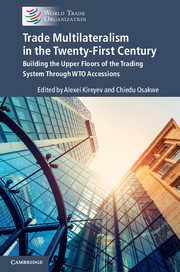 Trade Multilateralism in the Twenty-First Century
Trade Multilateralism in the Twenty-First Century from PART I - WTO Accessions and the New Trade Multilateralism
Published online by Cambridge University Press: 28 November 2017
Abstract
The world economy is showing signs of recovery after several years of lacklustre performance, although major policy uncertainties may easily upset this fragile trend. To jumpstart economies and trade after the financial crisis of 2008–9, governments across the world employed a traditional mix of fiscal, monetary and structural policies. These efforts helped to prevent a deeper crisis but fell short of pulling the world out of a period of stagnation in 2012–16. Trade, in particular, slowed relative to its historical performance and to overall economic growth. Meanwhile, political and social pressures have led to inward-looking policies in large countries. Other challenges – from civil and military conflicts to scattered terrorism – have also contributed to this inward turn. Against this background, this chapter discusses the need for a new and more flexible global economic architecture. It would require reforms at all levels, starting with revamping the structural foundations for growth and trade, applying solid, ground-level macroeconomic policies in individual countries, and rebuilding the upper floors of multilateral cooperation, i.e. upgrading it and making it more adaptable and responsive to the requirements of the twenty-first century. In the trade area, key pillars to support this structure include innovative mechanisms of trade liberalization in both new and traditional areas, increased inclusiveness of trade, recognition and financing of adjustment costs, effective communication on trade, a redefined role and functions for the WTO, upgraded multilateral rules and strong leadership. With radical changes needed, WTO accessions have already contributed, and could contribute even more, to each of these pillars.
For several years since the global financial crisis, the global economy has managed to avoid another systemic crisis and has been recovering gradually. However, growth has been low for so long that most people and businesses simply have not yet noticed that the economy was actually recovering. Weak economic growth, stagnant wages, high unemployment, and rising income inequality have stimulated support for inward-looking policies. Recovery has been sluggish and fragile, and its durability continues to be at risk. Recently some advanced economies have seen their GDP expand faster than expected, supported by a cyclical upturn in global manufacturing and trade. But at the same time, several emerging and advanced economies are still operating below capacity, and underlying core inflation is still low generally.
To save this book to your Kindle, first ensure [email protected] is added to your Approved Personal Document E-mail List under your Personal Document Settings on the Manage Your Content and Devices page of your Amazon account. Then enter the ‘name’ part of your Kindle email address below. Find out more about saving to your Kindle.
Note you can select to save to either the @free.kindle.com or @kindle.com variations. ‘@free.kindle.com’ emails are free but can only be saved to your device when it is connected to wi-fi. ‘@kindle.com’ emails can be delivered even when you are not connected to wi-fi, but note that service fees apply.
Find out more about the Kindle Personal Document Service.
To save content items to your account, please confirm that you agree to abide by our usage policies. If this is the first time you use this feature, you will be asked to authorise Cambridge Core to connect with your account. Find out more about saving content to Dropbox.
To save content items to your account, please confirm that you agree to abide by our usage policies. If this is the first time you use this feature, you will be asked to authorise Cambridge Core to connect with your account. Find out more about saving content to Google Drive.